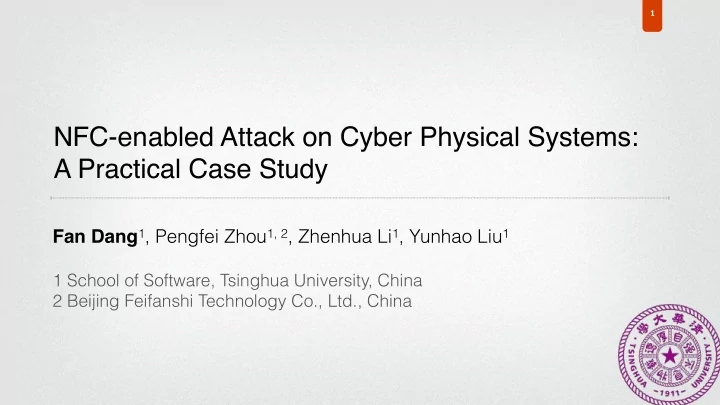

1 NFC-enabled Attack on Cyber Physical Systems: A Practical Case Study Fan Dang 1 , Pengfei Zhou 1, 2 , Zhenhua Li 1 , Yunhao Liu 1 1 School of Software, Tsinghua University, China 2 Beijing Feifanshi Technology Co., Ltd., China
2 Outline � 01 Introduc)on 02 Prior work 03 Our contribu)ons 04 Discussion and conclusions
3 Introduction � MIFARE Classic Processor Cards
4 Introduction � NFC with external SE (SD/SIM) NFC with embedded SE / HCE
5 Introduction �
6 Prior work � Eavesdropping credit cards… Relay with mobile phones Relay with self-build hardwares… Before HCE After HCE
7 Prior work � Experimental Setup much work [Hancke’09] [Francis’10] [Verdult’11] [Markantonakis’12] In Practice effort to prove feasible [Bond’14]
8 Beijing Municipal Traffic Card ISO/IEC 14443-4 based Weakness in top-up
9 Card Terminal Generate Random Number (R) Secret Secret Key (K) Key (K) =? Reject Accept External Authentication: a card verifies a terminal
10 Terminal Card Generate Random Number (R) Secret Secret Key (K) Key (K) =? Reject Accept Internal Authentication: a terminal verifies a card
11 Master Key (owned by the issuer) …… Card 1 Card 2 Card n Derivated Key Derivated Key Derivated Key DK = 3DES( ASN , MK ) + 3DES( ∼ ASN , MK )
12 issuer POS card protocol phase read binary preprocess application serial number (ASN) DLK = derivate (MLK, ASN) DTK = derivate (MTK, ASN) Internal init with amount and POS id initialize for load Auth balance, ATC, UN � MAC1 = MAC(balance, amount, POS id) online verification transaction time MAC2 = MAC(amount, POS id, time) External transaction time, MAC2 Auth credit for load TAC = MAC(balance, ATC, amount, POS id, time � online verification
13 Status Words Explanation 9000 Success 6E00 CLA incorrect 9302 MAC invalid 9303 Application locked
14 issuer POS card protocol phase read binary preprocess application serial number (ASN) DLK = derivate (MLK, ASN) DTK = derivate (MTK, ASN) init with amount and POS id initialize for load balance, ATC, UN � MAC1 = MAC(balance, amount, POS id) online verification transaction time MAC2 = MAC(amount, POS id, time) transaction time, MAC2 credit for load TAC = MAC(balance, ATC, amount, POS id, time � online verification 9302
15 BMAC on an NFC reader The emulated card A top-up software
16
17 The problem � Message passing through unreliable channels cannot create common knowledge . Common Knowledge and Common Belief Hans van Ditmarsch, Jan van Eijck, Rineke Verbrugge
18 Defenses � 1. No refund after generating MAC 2. Try detecting relay attack
19 Discussion � 1. EZ-Link (Singapore) CREDIT command has a failure status 2. Oyster (London) A CREDIT command is wrapped in a TRANSACTION command, which also has a failure status. 3. CIPURSE (Barcelona, Perm, Medellin) Similar to Oyster. 4. Octopus (Hong Kong) FeliCa, impossible to relay currently.
20 Conclusions � 1.We analyze the weakness of ISO/IEC 14443-4 when facing a relay attack. The flaw appears quite general to all kinds of AFC systems following this standard globally. 2.We design a relay experimental method and perform the relay attack. The result shows that the protocol is vulnerable. 3.We propose two attack countermeasures, and discuss the feasibility and practicality of these countermeasures.
Q&A
Recommend
More recommend